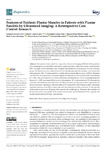Mostrar o rexistro simple do ítem
Features of Extrinsic Plantar Muscles in Patients with Plantar Fasciitis by Ultrasound Imaging: A Retrospective Case Control Research
| dc.contributor.author | López-López, Daniel | |
| dc.contributor.author | Canosa-Carro, Lorena | |
| dc.contributor.author | García Sanz, Fernando | |
| dc.contributor.author | Díaz-Meco-Conde, Raquel | |
| dc.contributor.author | García-Bermejo, Paula | |
| dc.contributor.author | De-la-Cruz-Torres, Blanca | |
| dc.contributor.author | Marszalek, Jolanta | |
| dc.contributor.author | Romero Morales, Carlos | |
| dc.date.accessioned | 2022-05-04T08:08:24Z | |
| dc.date.available | 2022-05-04T08:08:24Z | |
| dc.date.issued | 2022-04 | |
| dc.identifier.citation | Canosa-Carro, L.; López-López, D.; García-Sanz, F.; Díaz-Meco-Conde, R.; García-Bermejo, P.; de-la-Cruz-Torres, B.; Marszalek, J.; Romero-Morales, C. Features of Extrinsic Plantar Muscles in Patients with Plantar Fasciitis by Ultrasound Imaging: A Retrospective Case Control Research. Diagnostics 2022, 12, 897. https://doi.org/10.3390/diagnostics12040897 | es_ES |
| dc.identifier.uri | http://hdl.handle.net/2183/30590 | |
| dc.description.abstract | [Abstract] The present study aimed to compare by ultrasound imaging (USI) the tibial posterior (TP), medial gastrocnemius (MG) and soleus muscle in patients with and without plantar fasciitis (PF). A sample of 42 individuals was recruited and divided into two groups: PF and a healthy group. The thickness, cross-sectional area (CSA), echointensity and echovariation were assessed in both groups by USI. TP, soleus and MG variables did not report differences (p > 0.05) for thickness and CSA. For the echotexture parameters significant differences were found for MG echointensity (p = 0.002), MG echovariation (p = 0.002) and soleus echointensity (p = 0.012). Non-significant differences (p > 0.05) were reported for soleus echovariation, TP echointensity and TP echovariation variables. The thickness and CSA of the TP, GM and soleus muscle did not show significant differences between individuals with and without PF measured by USI. Muscle quality assessment reported an increase of the MG echointensity and echovariation, as well as a decrease of echointensity of the soleus muscle in the PF group with respect to the healthy group. Therefore, the evaluation of the structure and muscle quality of the extrinsic foot muscles may be beneficial for the diagnosis and monitoring the physical therapy interventions. | es_ES |
| dc.language.iso | eng | es_ES |
| dc.publisher | MDPI | es_ES |
| dc.relation.uri | https://doi.org/10.3390/diagnostics12040897 | es_ES |
| dc.rights | Atribución 4.0 Internacional | es_ES |
| dc.rights.uri | http://creativecommons.org/licenses/by/4.0/ | * |
| dc.subject | Ultrasonography | es_ES |
| dc.subject | Ultrasonografía | es_ES |
| dc.subject | Plantar fasciitis | es_ES |
| dc.subject | Fascitis plantar | es_ES |
| dc.subject | Diagnósticos | es_ES |
| dc.subject | Diagnostics | es_ES |
| dc.subject | Imaging | es_ES |
| dc.title | Features of Extrinsic Plantar Muscles in Patients with Plantar Fasciitis by Ultrasound Imaging: A Retrospective Case Control Research | es_ES |
| dc.type | info:eu-repo/semantics/article | es_ES |
| dc.rights.access | info:eu-repo/semantics/openAccess | es_ES |
| UDC.journalTitle | Diagnostics | es_ES |
| UDC.volume | 12 | es_ES |
| UDC.issue | 4 | es_ES |
| UDC.startPage | 897 | es_ES |
| dc.identifier.doi | 10.3390/diagnostics12040897 |
Ficheiros no ítem
Este ítem aparece na(s) seguinte(s) colección(s)
-
GI-UDISAP - Artigos [186]






